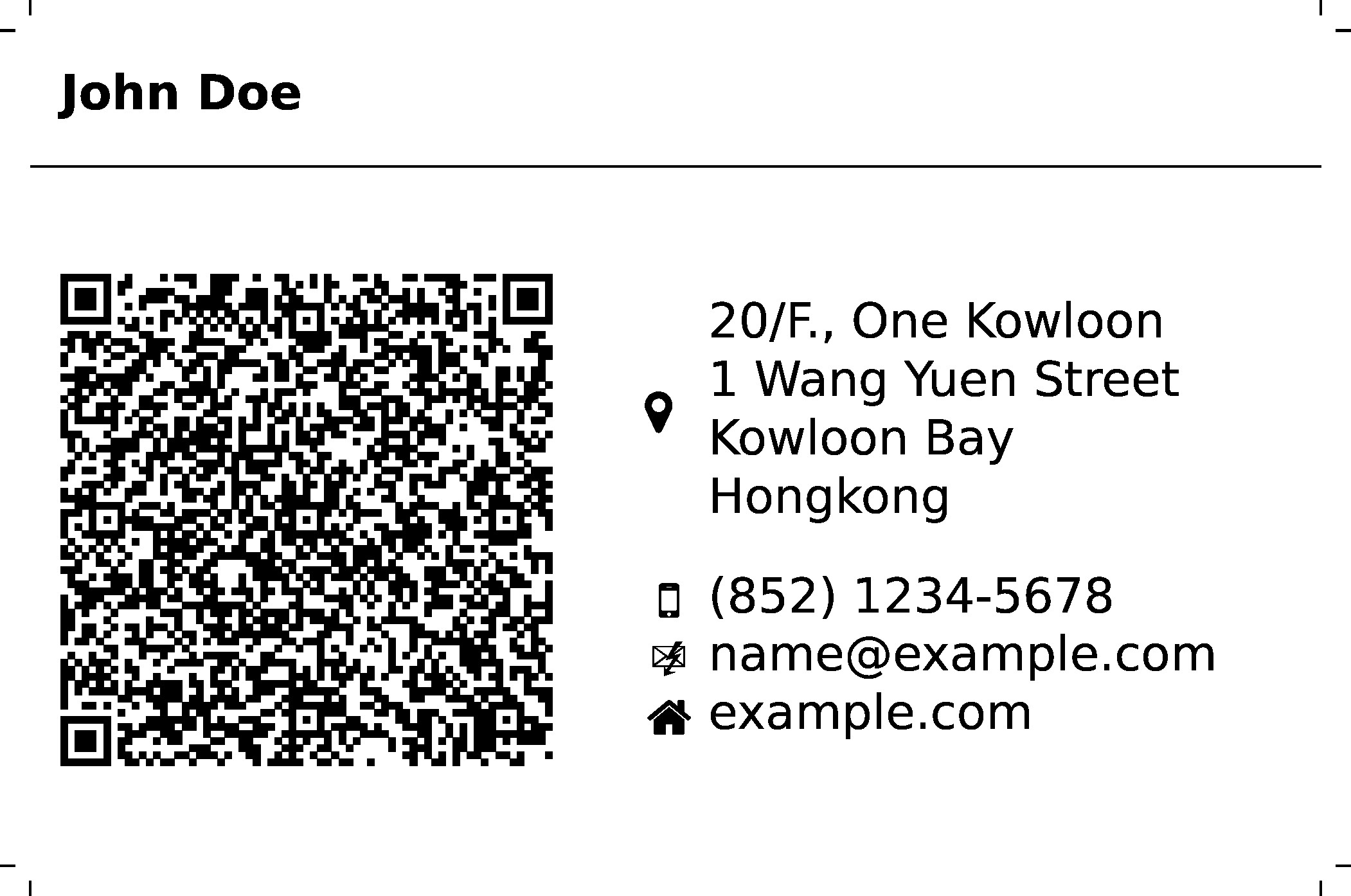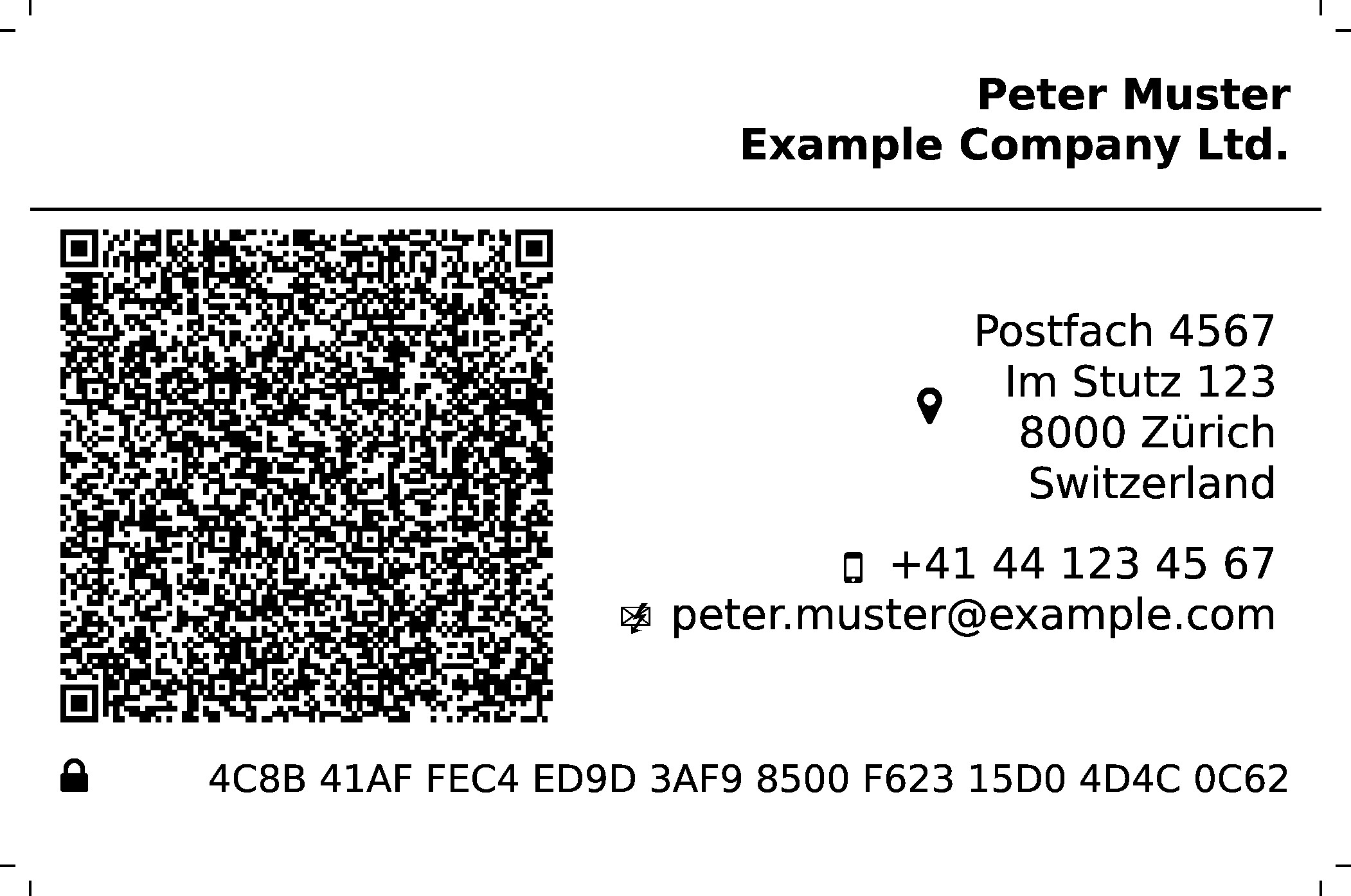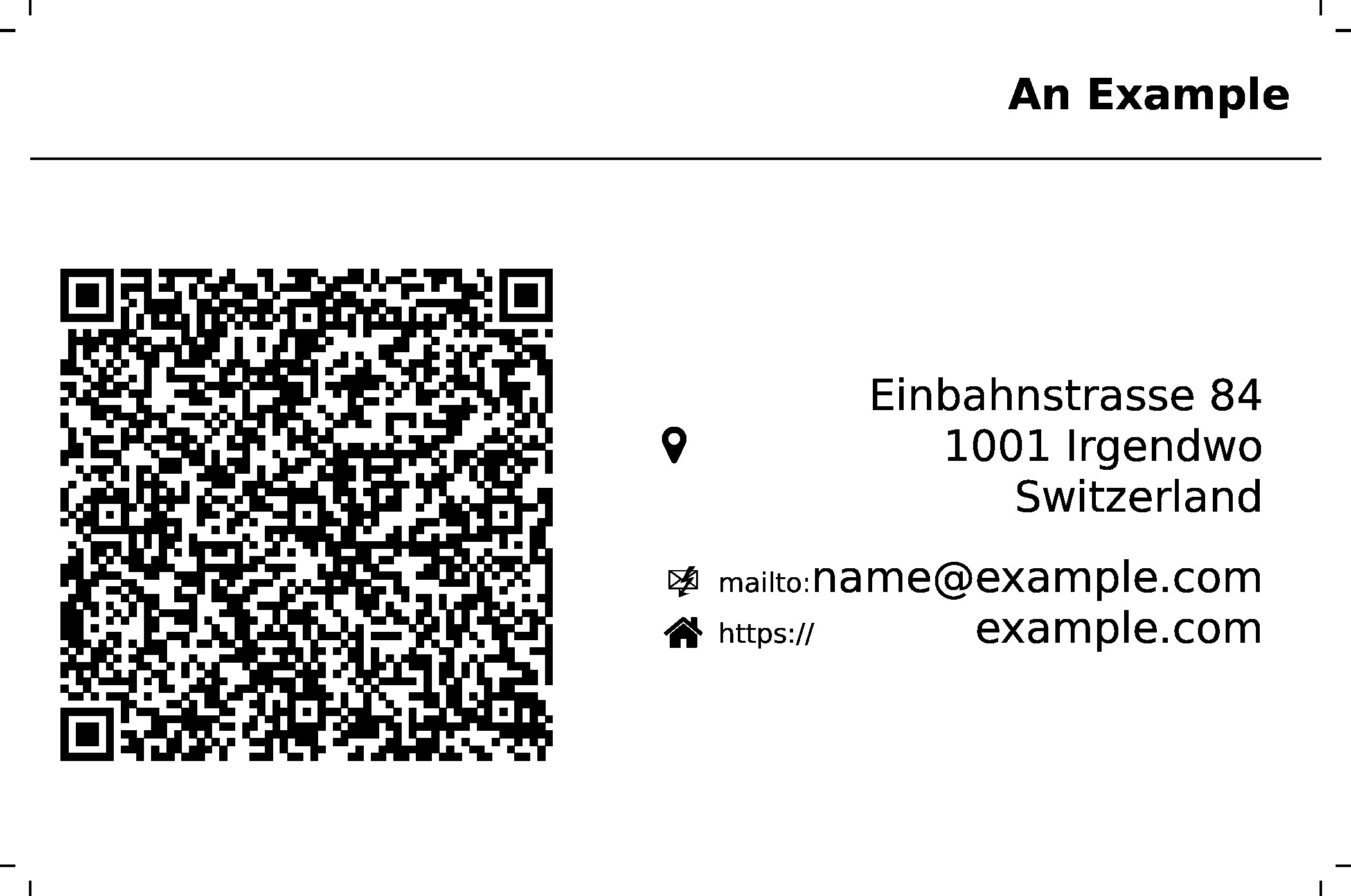11 KiB
Businesscard with QR-Code
What happens, if you give your visitin card to someone? Either he manually types the text into his computer or mobilefone, or it will end up in a box and be forgotten. Nowadays data is required electronically, not on paper. Here is the solution: A visiting card with QR-Code that contains a full vcard, so that it can be scanned with an app on the mobilefone and therefore automatically imported into the electronic contacts. This also works well, when you are offline and bluetooth transfer fails. So here is the highly configurable businescard or visitingcards with full vcard as QR-Code, ready to send to online printers.
Other available visitingcard templates, such as mschlenker distribute the cards on an A4 paper. But if you want a professional printer, such as onlineprinters, then you need to be able to generate a PDF with exactly one card, an exactly defined border and crop marks. That's why I wrote this template: You can specify the exact size of the paper and the content within the paper, inluding generation of crop marks.
Features
- all information is in the QR-Code
- full privacy control: input is optional, specify only what you need, you decide what information to share, e.g. I print three cards, with phone and address, without address and only with electronical contacts, no phone nor address
- optional icons, optional small hint texts
- several alignments
- freely defined size of paper and content
- supports honoric titles, full names, address with post office box and extended information
- supports telefone, email, jabber and matrix chat
- supports several urls for your hompages
- supports gitea, github, git
- supports facebook, twitter, google+, youtube, wikipedia
- supports pgp key url and fingerprint
- supports nextcloud federation id
Usage Example
Important: You must use xelatex for compilation, because xelatex properly supports UTF-8 (e.g. needed for german umlauts or chinese characters). The package inputenc messes up with package qrcode.
Include the documentclass, define your date and add the document part:
\documentclass{businesscard-qrcode}
\def\type{home}
\def\printaddress{}
\def\givennames{An}
\def\familynames{Example}
\def\street{Einbahnstrasse 84}
\def\city{Irgendwo}
\def\zip{1001}
\def\country{Switzerland}
\def\homepage{example.com}
\def\email{name@example.com}
\begin{document}
\drawcard
\end{document}
Save it as file texstudio_d30266.tex and compile it to get texstudio_d30266.pdf:
xelatex -synctex=1 -interaction=nonstopmode texstudio_d30266.tex
See examples for more examples.
Documentclass Options
Layout options are set as options to the \documentclass, e.g.:
\documentclass[textwidth=0.7,qrwidth=0.25,www,nofill,iconright,rightalign,hint,icon,textfirst]{businesscard-qrcode}
Available options:
paperwidth: width of the physical paper where the card is printed on (incl. border), default:89mmpaperheight: height of the physical paper where the card is printed on (incl. border), default:59mmcontentwidth: width of the card's content without the border that is cut, default:85mmcontentheight: height of the card's content without the border that is cut, default:55mmfontsize: any fontsize allowed inextarticle, that are8pt,9pt,10pt,11pt,12pt,14pt,17ptand20pt, default:8ptpadding: padding within the card's content, default:2mmcutdist: distance inmmwhere the cut marks are set, default:2cutlen: length of the cut marks inmm, default:1textwidth: relative width of the text block1means full width, soqrwidthplustextwidthshould be smaller than1the remainig space is left empty between the text and QR-Code, default:0.55(that's 55% of the available space)qrwidth: relative width of the QR-Code1means full width, soqrwidthplustextwidthshould be smaller than1the remainig space is left empty between the text and QR-Code, default:0.40(that's 40% of the available space)lang: language of the wikipedia page, will be prepended beforewikipedia.org, e.g.de.wikipedia.org, default:deaddressornoaddress: disable rendering of the address in text and QR-Code, default: addresshintornohint: show the little text hints, default:hinticonornoicon: show the icons, default:iconrightalignorleftalign: align text left or right, default:rightaligniconleftoriconright: show icon left or right of the text, default:iconleftfillornofill: fill empty space between icon and text, default:fillqrfirstortextfirst: switch position of QR-Code and text block, default:qrfirsthttpsorwww: should links in the hints be prefixed withhttps://orwww., default:https
Data Definitions
Your data is entered as definitions in the document, e.g.:
\def\email{name@example.com}
Please note, that spaces must be escaped, otherwise they do not appear in the QR-Code. You may not escape the spaces in your phone number, if you want them in the text, but not in the QR-Code, e.g.:
\def\givennames{Juan\ Pablo}
\def\familynames{Martínez\ Escudero}
\def\phone{+41 52 123 45 67}
Recognized definitions:
type: eitherhomeorworkfor personal or business cardsgivennames: your first name and eventual middle namesfamilynames: your family nameshonoricprefix: honorix name prefixes, e.g. academic titleshonoricsuffix: honoric name suffixesadditionalnames: additionl names — I use it for the company name in business cardspobox: post office boxextaddr: address extension, e.g. name of a building or floor numberstreet: street and number of the addresscity: name of the address locationregion: region of the addresszip: zip code of the addresscountry: full name of country of the address in the language of the cardphone: your phone number, the phone is marked as mobile, so to be used for voice and text (SMS)email: your email addressjabber: your jabber or xmpp chat addressmatrixorg: your matrix chat addres, hint: use riot messenger for matrixcloud: your nextcloud federation id — the url is prepended automaticallyhomepage: url to a web site with «home» icon — withouthttps://notwww(unless it is required), this is prepended automaticallyworld: url to a web site with «world» icon — withouthttps://notwww(unless it is required), this is prepended automaticallylink: url to a web site with «link» icon — withouthttps://notwww(unless it is required), this is prepended automaticallywordpress: url to a web site with «wordpress» icon — withouthttps://notwww(unless it is required), this is prepended automaticallydrupal: url to a web site with «» icon — withouthttps://notwww(unless it is required), this is prepended automaticallyjoomla: url to a web site with «joomla» icon — withouthttps://notwww(unless it is required), this is prepended automaticallywikipedia: if you or your company have a wikipedia entry, specify documentclass optionlangfor the language of you entry and use this definition for the name of your page — the url is prepended automaticallygit: the url of your git repository — withouthttps://notwww(unless it is required), this is prepended automaticallygitea: the url of your gitea project page, you can use this tag also for other project management sites, such as gogs — withouthttps://notwww(unless it is required), this is prepended automaticallygithub: your account name on github — only the name of the account, the url is prepended automaticallyfacebook: your account name on facebook or the name of your page — only the name of the account or page, the url is prepended automaticallytwitter: your account name on twitter — only the name of the account, the url is prepended automaticallyyoutube: your account name on youtube — only the name of the account, the url is prepended automaticallygoogle: your account name on google+ — only the name of the account, the url is prepended automaticallypgpurl: the full url to your pgp public key (only added to the QR-Code, not shown in the text)pgpfingerprint: the fingerprint of your pgp public key
Need More
If you are missing a feature or a configuration option, just open a ticket and I will care about it.



